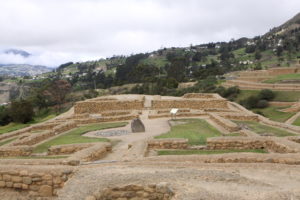This was our last chance to make a road trip while in Cuenca. Tomorrow we have to finish up a little shopping and start packing to return to the States. Troy and I along with Thomas our grandson decided to go to Ingapirca one of the best preserved Canari and Incan sites in Ecuador. The bus station was not a mad house and we were able to purchase our tickets in no time and the round trip was only $21.00. Luckily we got assigned seats both ways because the bus was a pig trail and filled up with locals and all their goods quickly. We passed through Azogues a beautiful little city and Canari where the descendents of those ancient people still live. Men and women alike wear a round white hat with little tassels hanging from the front or the back. We can’t determine why some wear them one way and some another. The children also wear these little hats with their school uniforms. I am happy to see that they hold to many of their traditions.
The trip up the mountain was beautiful. We climbed another thousand feet and the valleys were home to little villages, Holstein cattle, sheep, pigs and chickens. Pampas grass was eight feet tall along side the road and Shasta daisies grown wild. No matter how poor the house there were geraniums or roses in the yard. Men and women worked in the field side by side. The wife wears her beautiful velvet skirt with a scalloped hem laden with brightly colored sequins. These ladies have a sturdy peasant body, but they are very feminine. Long gold earrings, beads and a lacy blouse are a part of their dress even when doing hard labor.
Ingarpica is a World Heritage Site and very well protected. Our guide spoke excellent English and gave us a good understanding of what society was like in this area. The Canari and Incans shared this spot, but working together they could not keep the Spanish away from their Empire. They were agricultural and had silos that stored two year’s supply of food. They had a trade route that went from Peru to Columbia and many believe in to North America. They were scientist who practiced astronomy, studied the moon to determine when to plant their crops, they were shepherds, weavers, and knew how to use precious metals. Instead of learning from them the Spanish destroyed every thing that they had accomplished. Thomas wisely observed that ISIS today is trying to do the same thing today. Destroying a culture.
 This is a twenty eight day calendar. The Incans would fill the holes with water and study the moons reflection each night. They began to understand the passage of time and used this calendar to plant their crops.
This is a twenty eight day calendar. The Incans would fill the holes with water and study the moons reflection each night. They began to understand the passage of time and used this calendar to plant their crops.
 The Canari and the Inca shared the site, but their building techniques were very different.
The Canari and the Inca shared the site, but their building techniques were very different.
The Canari structures were round and the Incan rectangular.
 This is an Incan structure. These structures were storage buildings and shops. As we left the ruins, I looked out over the valley and saw the ghosts of these early people living their lives in a most idyllic manner under the arrival of the conquestidores.
This is an Incan structure. These structures were storage buildings and shops. As we left the ruins, I looked out over the valley and saw the ghosts of these early people living their lives in a most idyllic manner under the arrival of the conquestidores.
